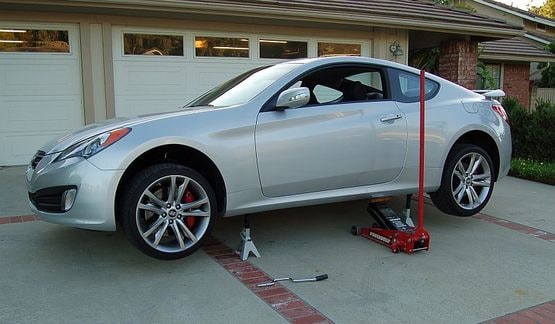
My suspension walkaround series was bound to catch up with our long-term test fleet eventually. So today we'll take a tour of one of the many cars that spend but a week or two in our hands, the 2009 Hyundai Genesis Coupe.
This example happens to be a V6 powered 6-speed manual version with the Track suspension configuration. Everything you're about to see applies to the other versions of the car except a few, well, exceptions that I'll point out along the way.
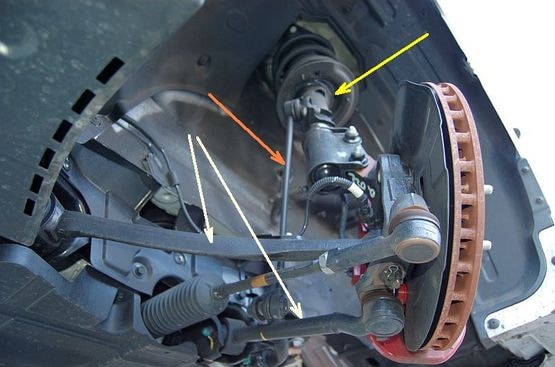
The front end of the Genesis Coupe has the same basic layout you'll find in a BMW 3-series: A strut suspension with dual pivots on the lower end and two distinct links (white) instead of a one-piece lower control arm. The stabilizer bar drop-link (orange) connects directly to the strut body (yellow) for a near 1:1 motion ratio and maximum efficiency.
The use of steel and iron instead of aluminum is one the reasons why Hyundai has been able keep the starting price of this car in the low $20k range, despite the moderately higher cost of such a dual-pivot setup.

As we've seen before, the dual pivot layout creates a virtual pivot point further outboard, which reduces the scrub radius and improves steering precision and straight stability while reducing kickback.
And since the Genesis Coupe is a rear-wheel drive car, there's room for a front-mounted steering rack (white). Locating the steering ahead of the front axle is another move that enhances steering precision.

The red Brembo 4-piston fixed brake calipers are the only obvious visual clue that this Genesis Coupe has the Track equipment package. Track suspension also includes a larger stabilizer bar (white), firmer springs and unique internal strut damping that is only identifiable by part number.
Added Sept 3: The Track front stabilizer bar diameter is 25 mm, 1 mm more than non-Track cars. The above springs are 9% firmer and the brake rotors are 13.4 inches instead of the 12.6-inch rotors and single-piston sliding brake calipers that come on a non-Track car.
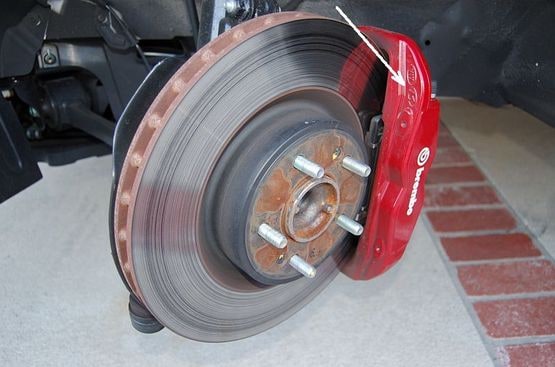
Those red Brembo 4-pot brake calipers are clamping onto generously vented one-piece rotors. Note the Hyundai and Kia logs cast into the caliper body. Hyundai and Kia are essentially the same company from an engineering standpoint, so you see this dual logo stamped onto parts all over the car.
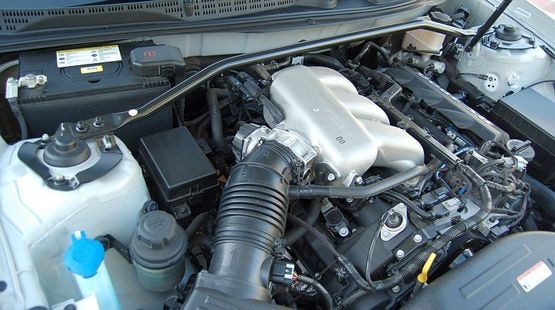
A simple tower-to-tower stress bar attaches to the upper strut mounting points to help stiffen these critical suspension locating points. Note the rear-mounted battery that helps shift weight distribution back a bit. And you can actually see the engine in this car -- there's no plastic cover to make this a sterile and uninviting place.

On to the rear suspension! And please don't tell anyone I robbed this phot from the other side of the car and flopped it for driver's side continuity. Maybe they won't notice the Obmerb brakes.
Anyway, this is about as multi as a multilink suspension can get. There are five in all, but only 4 are somewhat visible in this photo. I've indicated them in pairs: white indicates the upper pair and black indicates the lower pair. As we've seen many times now, the lower rear link is spread wide to act as a lower spring mount.
The missing link (ha!) is the toe link. We'll see more of it soon.

In fact, the yellow arrow has it in its sights. This view also shows how the two upper links (white) and the two lower links (black) locate the wheel and control camber and caster while the toe-link keeps it pointed in the right direction.
And that "right direction" changes as the suspension strokes up and down. The stubby length of the toe link means it will pull the tire in at the front (toe-in) as the outside tire compresses in hard cornering, thereby adding a dab or stabilizing roll understeer at the critical moment.
Other items of note: Steel is used for the knuckle (green) and all the other parts to save money and keep this car affordable. Could aluminum raise the performance bar further? Sure, but that'd cost more. This car does very well for its price point.
Rear alignment is adjustable via cams (orange) on the toe link and the rear lower link.

The two lower links attach to the knuckle in the foreground. In the background, the inclined plane of their inner pivots is indicative of anti-squat geometry. As the name implies, anti-squat reduces the tendency of the rear suspension to compress overmuch when you drop the hammer.
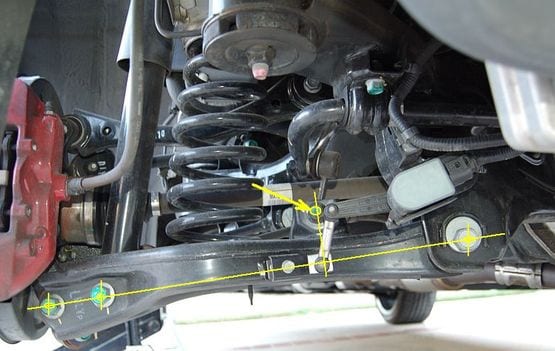
Here we have a cavalcade of motion ratios -- and a surprise. Let's start from left to right.
The shock absorber mounts just inside of the outer pivot, fo a motion ratio of what looks like 0.85. One inch of wheel travel will compress the shock 0.85 inches. The coil spring is next, and it looks like it has a motion ratio of a little over 0.6. The spring rate will have to be proportionally higher in order to achieve the desired rate at the tire contact patch, and that means a heavier spring and a tad more weight. Further in where the stabilizer bar bolts to the lower link. Here the motion ratio is but 0.35 or so, meaning the stab bar needs to be stiff and have short arms to have much of an effect. It's not terribly effecient, but stabilizer bars always end up with the leftovers when it comes to packaging -- this isn't an uncommon state of affairs.
Added Sept 3: The rear stabilizer bar on this Track car is 22 mm in diameter while the regular car gets a 19 mm bar. These rear springs are 15% stiffer than the standard ones.
You might not be able to see the actual stabilizer bar attachment point clearly because there's something in the way. It looks like a suspension height sensor. What the heck is that doing there?

Yep, it's a suspension height sensor. But I checked all four corners of the car and this is the only one present. Furthermore, the Genesis coupe does not have computer-controlled dampers.
That left one possible function: automatic headlamp levelling for the HID lighting. It makes sense that the rear is the critical axle, as the load varies most in the back as passengers and cargo are added and removed. But I'm not so sure that a Genesis coupe is going to see a lot of passengers or cargo in actual practice. After all, it's not a hatchback and my 5'1" daughter felt a lack of headroom in the back seat. (She had an inch or two to spare, but she's used to 6 or 12 inches of space to the headliner -- she's in minivans a lot.)
Whatever. It seems like overkill to me.
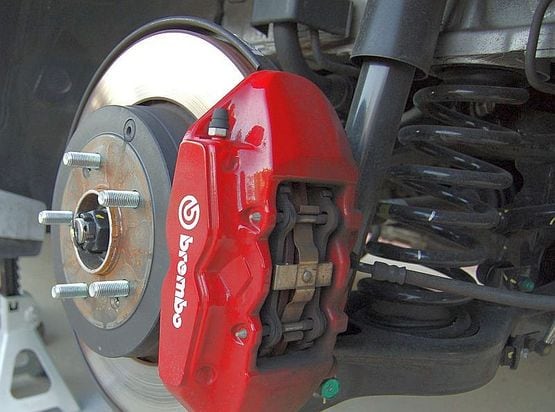
Another set of 4-piston fixed calipers by Brembo do the rear braking duties. Like the front, the pads are easily changed without removing anything but a couple of pins. You can't see it here, but these calipers have dual bleeder ports. It's also hard to see that those rear rotors are indeed ventilated.
Added Sep 3: These rotors measure 12.6-inches in diameter. The non-Track car has single-piston sliding calipers and 12.4-inch rotors.
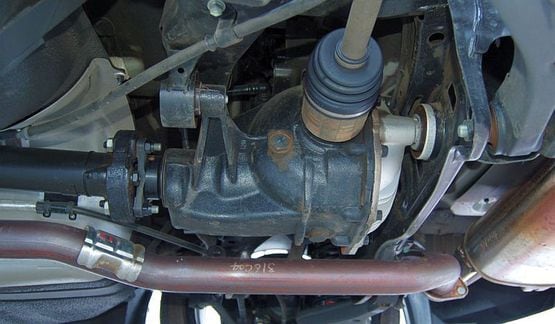
The Genesis Coupe is of course rear-wheel drive. Inside the diff housing is a Torsen torque-sensing differential to help put the power down.
Added Sep 3: The trick Torsen diff on comes on cars with the Track package. All others use a basic open differential.
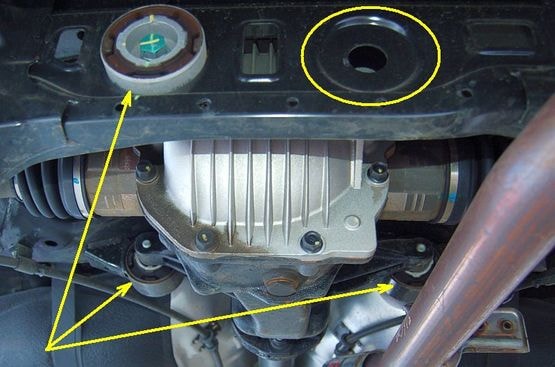
Look under enough cars and you'll see this from time to time. The rear differential is mounted in 3 places, but it looks like a 4-point mounting was considered earlier in the program. Think about it: are four chair legs as easy to balance as three? Of course not. Tripods and three-legged barstools rule. It's not precisely the same situation with vibrations, but the principle applies.

Of course all of these suspension and brake components do their thing through four tire contact patches. Here the fronts are 225/40R19 Y-rated summer performance tires. Mounted on their 8" x 19" rims (with a 35mm offset), they weigh 55.5 pounds. The rears are 245/40R19 and they weigh 58 pounds together with their 8.5" x 19" and 35mm offset rims.
The car we've got here, a V6 Genesis Coupe Track with a 6-speed manual, costs $29,950 before you start piling on the options. But this same suspension design -- apart from the Brembos, the 19" summer rubber and the Track tuning of the suspension -- sits beneath the cheapest 4-clyinder turbo version that starts at $22,000. All in all, there's a lot of RWD performance going on here at the entry level.


